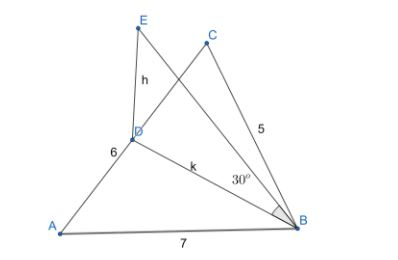
Consider a triangular plot ABC with sides $AB=7m$, $BC=5m$ and $CA=6m$. A vertical lamp post at the mid-point D of AC subtends an angle ${{30}^{o}}$ at B. Find the height of the lamp post in m?
(a) $7\sqrt{3}$,
(b) $\dfrac{2}{3}\sqrt{21}$,
(c) $\dfrac{3}{2}\sqrt{21}$,
(d) $2\sqrt{21}$.
Answer
574.5k+ views
Hint: We start solving the problem by drawing all the given information. We assume the height of lamp post be h and find the length of the median BD in terms of h. Now, we use the formula $A{{B}^{2}}+B{{C}^{2}}=2\times \left( A{{D}^{2}}+B{{D}^{2}} \right)$ to find the value of h. We make necessary arrangements to get the required value of h as per given in options.
Complete step-by-step answer:
Given that we have a triangular plot ABC with sides $AB=7m$, $BC=5m$ and $CA=6m$, there is vertical lamp post at the mid-point D of AC subtends an angle ${{30}^{o}}$ at B. We need to find the height of the lamp post in m.
Let us draw the given information to get a better view.

We know that the line which passes through the midpoint of the side and through the vertex opposite to the side is known as median. We know that median cuts sides into two equal parts. So, we get $AD=3m$.
From triangle BDE, we get $\tan \left( {{30}^{o}} \right)=\dfrac{DE}{BD}$.
$\Rightarrow \dfrac{1}{\sqrt{3}}=\dfrac{h}{BD}$.
\[\Rightarrow BD=h\sqrt{3}\]m.
We know the equation of the length of the squares of the sides is equal to twice the sum of the squares of the median and half of the other side.
So, we have $A{{B}^{2}}+B{{C}^{2}}=2\times \left( A{{D}^{2}}+B{{D}^{2}} \right)$.
$\Rightarrow {{7}^{2}}+{{5}^{2}}=2\times \left( {{3}^{2}}+{{\left( h\sqrt{3} \right)}^{2}} \right)$.
$\Rightarrow 49+25=2\times \left( 9+3{{h}^{2}} \right)$.
$\Rightarrow 74=18+6{{h}^{2}}$.
$\Rightarrow 56=6{{h}^{2}}$.
$\Rightarrow {{h}^{2}}=\dfrac{56}{6}$.
$\Rightarrow h=\sqrt{\dfrac{28}{3}}$.
$\Rightarrow h=\sqrt{\dfrac{7\times 4}{3}}$.
$\Rightarrow h=\dfrac{2\sqrt{7}}{\sqrt{3}}$.
$\Rightarrow h=\dfrac{2\sqrt{7}}{\sqrt{3}}\times \dfrac{\sqrt{3}}{\sqrt{3}}$.
$\Rightarrow h=\dfrac{2\sqrt{21}}{3}$.
∴ The height of the lamp post is $\dfrac{2\sqrt{21}}{3}m$.
So, the correct answer is “Option (b)”.
Note: Alternatively, we can solve problem as follows:
We have $A{{B}^{2}}+B{{C}^{2}}=\dfrac{1}{2}\times A{{C}^{2}}+2\times B{{D}^{2}}$.
$\Rightarrow {{7}^{2}}+{{5}^{2}}=\dfrac{1}{2}\times {{6}^{2}}+2\times {{\left( h\sqrt{3} \right)}^{2}}$.
$\Rightarrow 49+25=\dfrac{36}{2}+2\times 3{{h}^{2}}$.
$\Rightarrow 74=18+6{{h}^{2}}$.
$\Rightarrow 56=6{{h}^{2}}$.
$\Rightarrow {{h}^{2}}=\dfrac{56}{6}$.
$\Rightarrow h=\sqrt{\dfrac{28}{3}}$.
$\Rightarrow h=\sqrt{\dfrac{7\times 4}{3}}$.
$\Rightarrow h=\dfrac{2\sqrt{7}}{\sqrt{3}}$.
$\Rightarrow h=\dfrac{2\sqrt{7}}{\sqrt{3}}\times \dfrac{\sqrt{3}}{\sqrt{3}}$.
$\Rightarrow h=\dfrac{2\sqrt{21}}{3}$.
∴ The height of the lamp post is $\dfrac{2\sqrt{21}}{3}m$.
Complete step-by-step answer:
Given that we have a triangular plot ABC with sides $AB=7m$, $BC=5m$ and $CA=6m$, there is vertical lamp post at the mid-point D of AC subtends an angle ${{30}^{o}}$ at B. We need to find the height of the lamp post in m.
Let us draw the given information to get a better view.

We know that the line which passes through the midpoint of the side and through the vertex opposite to the side is known as median. We know that median cuts sides into two equal parts. So, we get $AD=3m$.
From triangle BDE, we get $\tan \left( {{30}^{o}} \right)=\dfrac{DE}{BD}$.
$\Rightarrow \dfrac{1}{\sqrt{3}}=\dfrac{h}{BD}$.
\[\Rightarrow BD=h\sqrt{3}\]m.
We know the equation of the length of the squares of the sides is equal to twice the sum of the squares of the median and half of the other side.
So, we have $A{{B}^{2}}+B{{C}^{2}}=2\times \left( A{{D}^{2}}+B{{D}^{2}} \right)$.
$\Rightarrow {{7}^{2}}+{{5}^{2}}=2\times \left( {{3}^{2}}+{{\left( h\sqrt{3} \right)}^{2}} \right)$.
$\Rightarrow 49+25=2\times \left( 9+3{{h}^{2}} \right)$.
$\Rightarrow 74=18+6{{h}^{2}}$.
$\Rightarrow 56=6{{h}^{2}}$.
$\Rightarrow {{h}^{2}}=\dfrac{56}{6}$.
$\Rightarrow h=\sqrt{\dfrac{28}{3}}$.
$\Rightarrow h=\sqrt{\dfrac{7\times 4}{3}}$.
$\Rightarrow h=\dfrac{2\sqrt{7}}{\sqrt{3}}$.
$\Rightarrow h=\dfrac{2\sqrt{7}}{\sqrt{3}}\times \dfrac{\sqrt{3}}{\sqrt{3}}$.
$\Rightarrow h=\dfrac{2\sqrt{21}}{3}$.
∴ The height of the lamp post is $\dfrac{2\sqrt{21}}{3}m$.
So, the correct answer is “Option (b)”.
Note: Alternatively, we can solve problem as follows:
We have $A{{B}^{2}}+B{{C}^{2}}=\dfrac{1}{2}\times A{{C}^{2}}+2\times B{{D}^{2}}$.
$\Rightarrow {{7}^{2}}+{{5}^{2}}=\dfrac{1}{2}\times {{6}^{2}}+2\times {{\left( h\sqrt{3} \right)}^{2}}$.
$\Rightarrow 49+25=\dfrac{36}{2}+2\times 3{{h}^{2}}$.
$\Rightarrow 74=18+6{{h}^{2}}$.
$\Rightarrow 56=6{{h}^{2}}$.
$\Rightarrow {{h}^{2}}=\dfrac{56}{6}$.
$\Rightarrow h=\sqrt{\dfrac{28}{3}}$.
$\Rightarrow h=\sqrt{\dfrac{7\times 4}{3}}$.
$\Rightarrow h=\dfrac{2\sqrt{7}}{\sqrt{3}}$.
$\Rightarrow h=\dfrac{2\sqrt{7}}{\sqrt{3}}\times \dfrac{\sqrt{3}}{\sqrt{3}}$.
$\Rightarrow h=\dfrac{2\sqrt{21}}{3}$.
∴ The height of the lamp post is $\dfrac{2\sqrt{21}}{3}m$.
Recently Updated Pages
Why is there a time difference of about 5 hours between class 10 social science CBSE

Master Class 12 Business Studies: Engaging Questions & Answers for Success

Master Class 12 Economics: Engaging Questions & Answers for Success

Master Class 12 English: Engaging Questions & Answers for Success

Master Class 12 Maths: Engaging Questions & Answers for Success

Master Class 12 Social Science: Engaging Questions & Answers for Success

Trending doubts
Who was the first woman to receive Bharat Ratna?

State and prove the Pythagoras theorem-class-10-maths-CBSE

State BPT theorem and prove it class 10 maths CBSE

What is the minimum age for fighting the election in class 10 social science CBSE

Describe the Salient Features of Indian Economy

The slogan Jai Hind was given by A Lal Bahadur Shastri class 10 social science CBSE




